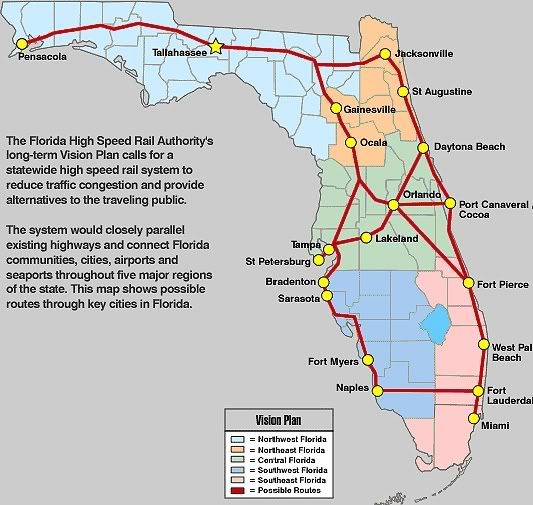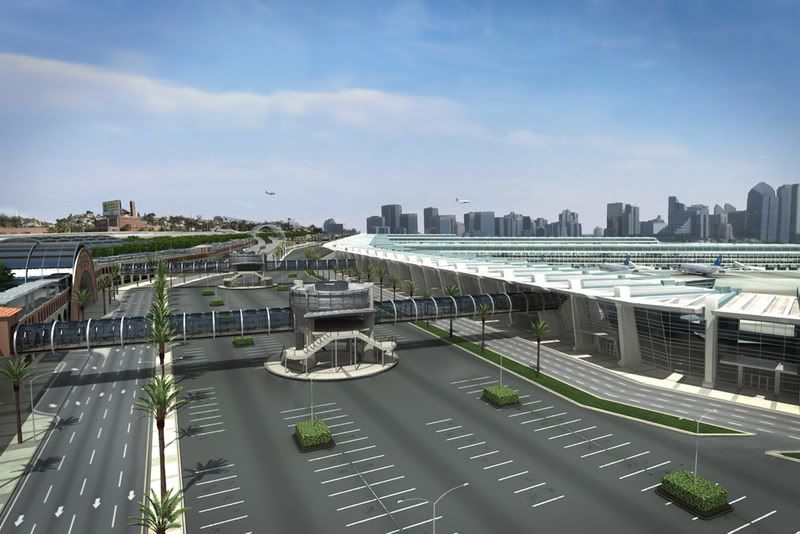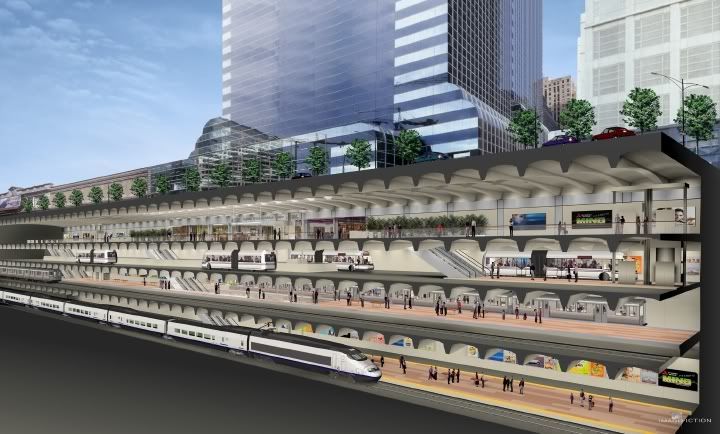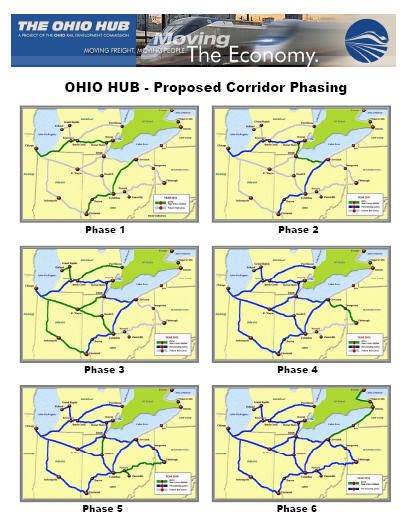(noon. – promoted by ek hornbeck)
Burning the Midnight Oil for Living Energy Independence
 Disclaimer: Nothing said here should be taken to imply that airport/train connections are the primary transport task for either light rail, mass transit, conventional intercity rail, or high speed intercity rail. In other words, the focus of an essay in a regular weekly series on one particular topic does not imply anything along the lines of “most important thing”.
Disclaimer: Nothing said here should be taken to imply that airport/train connections are the primary transport task for either light rail, mass transit, conventional intercity rail, or high speed intercity rail. In other words, the focus of an essay in a regular weekly series on one particular topic does not imply anything along the lines of “most important thing”.
However, recently, I keep running into the issue of taking the train to the airport. I read an recent article in an air travel industry publication that focused on the airport connections associated with the projects funded in the $8b HSR funding. I read an older piece about the proposed intermodal station in Chicago that would allow our Ohio trains to get to O’Hare. And the proposal to terminate the California HSR at the redesigned Lindbergh Field came up as part of the discussion at the California HSR blog.
So with the Super Bowl coming up to distract things, I succumbed to what was clearly fate, and am going to discuss taking the train to the airport.
The Green Dimension
It is, I hope, widely understood that the carbon footprint of flying is very high. What might not be as widely understood is that the shorter routes tend to be the least efficient routes. On a short flight, the extra fuel-consumption of take-off and landing is shared out among fewer route miles.
And further, aircraft are less efficient flying through the denser air closer to the surface, and more efficient when they reach “cruising altitude”. And of course, when flying from, say, Atlanta to Charlotte NC, or Columbus OH to Chicago, you spend the bulk of the flight either climbing to cruising altitude or descending from it.
And under present conditions, HSR demand focuses on trips of one to three hours, which are all short-haul flights in terms of flying. So not only can HSR be powered by sustainably generated electricity (either from the outset for 220mph Express HSR, or as part of ongoing upgrades, for 110mph Emerging HSR) … but the flights they will replace are those that have a higher carbon footprint per route mile than the average for flying.
Now, whether we will still be flying in 2050, to what extent, and for what types of journeys … we have to take whatever steps we can to cut our carbon footprint as soon as we can in order to get to 2050 more or less intact. And the above suggests that one early strategy is to make it possible to take a longer flight to an airport and then complete the journey by HSR.
Airports Aint Just Airports
Of course, for this strategy, it makes a difference what kind of airport it is. This is critical to the discussion of the Lindbergh Field Intermodal Transit Center (pdf) option in San Diego, which arises in some of the commentary on the California HSR blog post, How Will HSR Get to Downtown San Diego?.
 While the ITC is a very interesting proposal in terms of providing direct Trolley, Coaster and Amtrak Pacific Surfliner stops at the airport – Lindbergh Field is between one and two miles from downtown, and the existing Amtrak Pacific Surfliner terminus at Santa Fe is a much stronger location for the downtown San Diego HSR station. It is located on one Trolley line that runs to the border, adjcent to the trolley line to Petco field as well as one of the main downtown bus transfer centers. It is much more convenient to the Convention center and two blocks from the Coronado ferry.
While the ITC is a very interesting proposal in terms of providing direct Trolley, Coaster and Amtrak Pacific Surfliner stops at the airport – Lindbergh Field is between one and two miles from downtown, and the existing Amtrak Pacific Surfliner terminus at Santa Fe is a much stronger location for the downtown San Diego HSR station. It is located on one Trolley line that runs to the border, adjcent to the trolley line to Petco field as well as one of the main downtown bus transfer centers. It is much more convenient to the Convention center and two blocks from the Coronado ferry.
And with respect to the plane/train transfer scenario, San Diego airport is not a main hub airport, nor is its location promising for development into a main hub airport. So for plane/train transfers involving both San Diego and California HSR, the majority of transfers will be somewhere else in the state, with the trip either starting or ending at the San Diego HSR station.
So, while the Intermodal Transit Center is interesting as one transitional design for reducing vehicle miles traveled to the San Diego Airport – its the local rail connections that are critical for that impact. For the High Speed Rail, where San Diego is likely to have one suburban and one downtown station, Lindbergh Field seems to be too close to downtown to be the suburban station and seems to be too far from the key intra-state and interstate transport destinations in San Diego to be the downtown station.
OK, so what about O’Hare
O’Hare airport in Chicago is a clear contrasting example. This is a major western Great Lakes / eastern Midest transport hub. Any HSR network in this region would receive a benefit from connecting to O’Hare.
For existing Michigan and Indiana trains, and proposed Ohio Hub trains, the obstacle to getting to the airport is not the existence of an airport station – but rather that fact that O’Hare is on the western side of the Great Chicago Divide.
Most people are aware of the importance of Chicago status as a central rail hub in Chicago’s emergence as a major American city. Perhaps fewer are aware of the way that Chicago developed as a rail hub. This was in the late 1800’s, when large numbers of ofttimes shady characters were trying to make their fortune by building a railroad. The end result of the chaotic process was a system of lines running from Chicago to the east, and a system of lines running from Chicago to the west, with very little interconnection between the two systems.
 And of course, the reason that the Midwest Hub and Ohio Hub systems can be built out so much more quickly with so many more miles per dollar than the California HSR system is because they are starting out as 110mph Emerging HSR systems, built in existing rail corridors. So they stand to inherit the east/west divide.
And of course, the reason that the Midwest Hub and Ohio Hub systems can be built out so much more quickly with so many more miles per dollar than the California HSR system is because they are starting out as 110mph Emerging HSR systems, built in existing rail corridors. So they stand to inherit the east/west divide.
However, it is no secret that this is a problem, and so there are efforts underway to address these problems. One of these efforts is the West Loop Transportation Center
An appealing aspect of this proposal is that it means the downtown Chicago HSR station will be connected directly to Chicago Union Station and the Olgivie Transportation Center.
 The Chicago / Michigan corridor would be a primary beneficiary among those receiving funding from the $8b appropriated in Stimulus II, but later stages of the Midwest Hub to both Indianapolis and northern Indiana would also benefit from this through access … and of course the Ohio Hub, which was funded for its core seed corridor at conventional Amtrak speed, plans to connect to Chicago, first via the Michigan corridor, and then via the Indiana corridors.
The Chicago / Michigan corridor would be a primary beneficiary among those receiving funding from the $8b appropriated in Stimulus II, but later stages of the Midwest Hub to both Indianapolis and northern Indiana would also benefit from this through access … and of course the Ohio Hub, which was funded for its core seed corridor at conventional Amtrak speed, plans to connect to Chicago, first via the Michigan corridor, and then via the Indiana corridors.
And a whole collection of potential airport connections …
Some airport HSR connections are stations directly integrated into an airport terminal complex … others are HSR connections with local rail that has an airport station … others are connected to airports by less direct means.
For those choosing between an air/air transfer and an air/train transfer, the HSR station integrated into the airport terminal is obviously the ideal. However, for many people living in rural and outer suburban areas that the HSR passes through, the greater ease of access and quality of service at the regional HSR station will offset an additional transfer to connect to a hub airport.
On the other hand, we are talking about fewer than half of the passengers on a High Speed Rail service – so while an airport station is always an option to consider, going too far out of the way in order to stop at the airport is not automatically the correct choice.
And of course, while in some cases the die has been cast, either by the legacy of airport location choices and availability of transport corridors, in other cases, the decision has not been finalized yet.
Defending Aviation’s Market Share
How do we fund airport stations? You might think that since there is an Aviation Trust Fund that we regularly dip into for capital improvements, and since an airport HSR station is an obvious improvement in terms of offering transport alternatives to air passengers, that one way to fund the airport station itself, and in particular the extra capital cost of integrating into the passenger terminal rather than having a station “in the vicinity of” the airport, could apply for funding as a capital improvement to the airport.
Except the ideal is an intermodal through station, the HSR accesses the airport terminal, and where local transport accesses both the airport terminal and the HSR station. Which runs smack dab into the FAA regulations (pdf):
To be AIP and PFC eligible, the airport ground access transportation project must meet the following conditions: (1) The road or facility may only extend to the nearest public highway or facility of sufficient capacity to accommodate airport traffic; (2) the access road or facility must be located on the airport or within a right-of-way acquired by the public agency; and (3) the access road or facility must exclusively serve airport traffic.
There’s nothing in the first two that interferes with applying for these funds to cover the incremental capital cost of integrating the HSR station with an airport terminal: the problem is, of course, the third section. This is why so many light rail and other rail projects that go to airports terminate at the airport, since that is the easiest way to guarantee that the infrastructure on the airport property never, ever commits the unpardonable efficiency of serving multiple transport needs at the same time.
Indeed, if you press the point – and as far as I understand it, the FAA does indeed press the point – any through rail corridor must be automatically ineligible, since the passengers that are taking the train through and not using the airport station are automatically receiving service from the road that is not “exclusively for the airport”.
This is a national policy that could well be changed. Whether it could be changed by executive order, or requires new Congressional language, I do not know – I am not, after all, a lawyer, not even in the sense of playing on on the Internet – but whichever it is, that is a change that ought to be pursued.
The thing about this regulation is that it doesn’t matter how much of the use of the facility is to serve the airport, nor what the cost efficiency of the system is in terms of serving passengers to and from the airport … the simple fact that another use may be made of the facility is used to rule the project ineligible, so the usefulness and cost-effectiveness of the service to air passengers is never assessed.
A preferable limit for through rail services would be to the incremental capital cost of providing service to a passenger station directly integrated with an airport passenger terminal, restricted to infrastructure located on the airport property itself.
As argued above regarding Lindbergh Field in San Diego, an airport station is not automatically the preferred location for an HSR station. However, with the opportunities to engage in air/train transfers, and the existing ground transport connections to the airport, it is often an option worth considering.
However, because of the space hunger of airport runways, there is often an incremental capital cost in connecting an HSR corridor directly with an airport via an airport terminal station. Where the airport station turns out to be a cost effective way of providing improved transport connections to the airport, the decision should be made in terms of how effectively it serves to provide transport to and from the airports, and the efficiency of also providing additional service to others should not automatically rule it out.
Midnight Oil’s Beds are Burning / Various Artists

5 comments
Skip to comment form
Author
… its probably not Super Bowl Sunday.
ik neem altijd de trein naar de airport!
en ik fiets altijd naar mijn werk.
i take always the train to the airport (and to most other cities in the Randstad) and every day, elke dag, i bike to my work.
it’s great. it’s liberating. it makes me think i could do other, tougher things. like live without a constant flow of oil or even gas into the house. my dutchman’s parents lived in these 1930s row houses with nothing more than heat in the living room.
yeah.